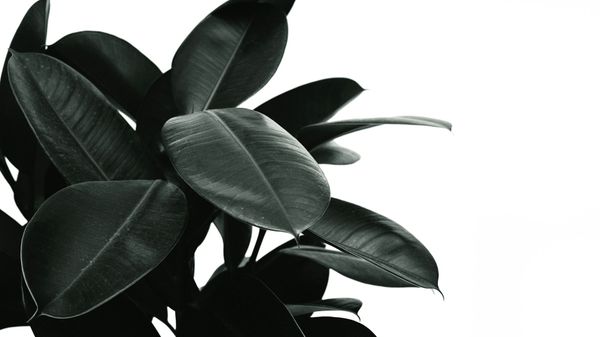Rubber Plant Care Guide
How to grow and care for Rubber Plant (Ficus elastica)
Ficus elastica, commonly known as the Rubber Plant, is a popular houseplant known for its broad, glossy leaves and minimal maintenance requirements. Originally hailing from South and Southeast Asia, this resilient plant adds a touch of elegance and lush greenery to indoor spaces. With the right care, Ficus elastica can grow to impressive heights, making it an excellent choice for rooms with high ceilings or to make a bold, natural statement.

Disclosure: This content includes affiliate links, which means we may earn a commission if you click on a link and make a purchase. As an Amazon Associate, we earn from qualifying purchases. This comes at no extra cost to you and helps offset the cost of running Leafwise. Please read our disclaimer for more info.
Table of Contents
Care
Light
Rubber Plants (Ficus elastica) thrive in bright, indirect light but can tolerate lower light conditions. Avoid direct sunlight, as it can scorch the leaves. For optimal growth, place the plant near a south or east-facing window with filtered light. Some morning sunlight is beneficial, but prolonged exposure to harsh direct light should be avoided.
Watering
Water when the top inch of soil feels dry. Water thoroughly, allowing excess water to drain out of the pot. Avoid overwatering, as it can lead to root rot. Reduce watering during the winter months when growth naturally slows.
Humidity & Temperature
Maintain a room temperature between 60°F and 85°F (15°C to 29°C). Rubber Plants prefer moderate to high humidity levels between 40% and 50%. Increase humidity by misting the leaves, placing a humidifier nearby, or using a pebble tray with water. Avoid sudden temperature changes and keep the plant away from drafts or air conditioners.
Soil
Use a well-draining potting mix to prevent water accumulation. A mix containing peat moss, perlite, and pine bark works well to retain moisture without waterlogging the roots. Ideally, the soil should be slightly acidic, with a pH range of 5.5 to 7.
Fertilization
Feed your Rubber Plant with a balanced, water-soluble fertilizer every 2-4 weeks during the growing season (spring and summer). For plants in lower light conditions, fertilize monthly. Reduce or stop fertilization in fall and winter when growth naturally slows.
Maintenance
Pruning
Prune the plant as needed to control its size and shape. Trim any dead, damaged, or yellowing leaves with clean, sharp pruning shears to encourage healthy growth. Regular pruning in late spring or early summer can also promote a bushier appearance and vigorous branching.
Cleaning
Wipe the large, glossy leaves regularly with a damp cloth to remove dust and improve light absorption. Clean leaves also help prevent pests from settling on the plant.
Repotting
Repot your Rubber Plant every 1-2 years or when it becomes root-bound. Use fresh, well-draining soil and a pot that is one size larger to accommodate its growth.
Propagation
Rubber Plants propagate best through stem cuttings:
- Select a healthy stem – Choose a cutting with at least one node and a healthy leaf.
- Make a clean cut – Use sterilized pruning shears to cut just below a node.
- Prepare the cutting – Allow the cut end to dry and callous for a few hours.
- Root in soil or water – Place the cutting in water, changing the water weekly, or plant it directly in moist, well-draining soil.
- Transplant – Once roots develop (in 4-6 weeks), transfer the cutting to a pot with fresh soil.
Common Issues
Yellowing Leaves
Cause: Overwatering, poor drainage, or nutrient deficiencies.
- Solution: Check the soil for excess moisture and improve drainage if needed. Water less frequently and allow the soil to dry out between waterings. Apply a balanced fertilizer if a nutrient deficiency is suspected.
Leaf Drop
Cause: Environmental stress, such as sudden temperature changes, drafts, or inconsistent watering.
- Solution: Maintain stable temperatures and avoid drafts. Water consistently and avoid moving the plant frequently.
Brown Edges or Spots on Leaves
Cause: Low humidity, underwatering, or salt buildup from excess fertilizer.
- Solution: Increase humidity by misting or using a humidifier. Ensure the plant is watered regularly, and flush the soil with water if salt buildup is suspected.
Pests (Spider Mites, Mealybugs, Scale)
Cause: Dry conditions, dusty leaves, poor airflow, or over-fertilization can attract common houseplant pests.
- Solution: Wipe the leaves with a mixture of water and mild dish soap to remove pests. Apply neem oil or insecticidal soap weekly until the infestation is gone. Improve humidity, airflow, and clean leaves regularly to prevent future problems.
Root Rot
Cause: Overwatering or poorly draining soil.
- Solution: Remove the plant from its pot, trim off any mushy or blackened roots, and repot it in fresh, well-draining soil. Reduce watering and ensure the pot has proper drainage.
With proper care, your Rubber Plant will reward you with lush, glossy foliage, making it a striking addition to your indoor space.
